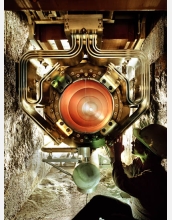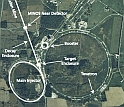|

Press Release 06-052
First Result from New Experiment Confirms Neutrino Oscillation

Studies may aid understanding of all matter
March 30, 2006
By sending a high-intensity beam of subatomic particles known as neutrinos from a laboratory in Batavia, Ill., to a particle detector located deep in a mine in Soudan, Minn., scientists have confirmed the neutrinos really do "oscillate," changing from one kind to another as they fly along.
The payoff could be a deeper understanding of the ghostly neutrino particles, which can traverse the entire Earth without interacting with matter. Ultimately, in fact, these elusive particles may help us understand the origins of the neutrons, protons and electrons that make up all the matter in the world around us.
Such oscillations have been observed in earlier experiments. But new experiments from the Main Injector Neutrino Oscillation Search (MINOS) based at the Fermi National Accelerator Laboratory will eventually examine the effect in much greater detail, and under controlled conditions.
"Using a man-made beam of neutrinos, MINOS is a great tool to study the properties of neutrinos in a laboratory-controlled environment," said Stanford University professor Stan Wojcicki, spokesperson for the experiment.
Their first result corroborates earlier observations of muon neutrino disappearance, made by the Japanese Super-Kamiokande and K2K experiments.
"Over the next few years, we will collect about 15 times more data, yielding more results with higher precision, paving the way to better understanding this phenomenon," Wojcicki said.
The U.S. Department of Energy funds most of MINOS through its support for Fermilab. The National Science Foundation and the United Kingdom's Particle Physics and Astronomy Research Council provide additional funding.
For more details, see the Fermilab news release.
-NSF-
MINOS Participating Institutions
|
Brazil:
University of Campinas
University of Sao Paulo
France:
College de France
Greece :
University of Athens
Russia:
ITEP-Moscow
Lebedev Physical Institute
IHEP-Protvino
United Kingdom:
University of Cambridge
University College London, London
University of Oxford
Rutherford Appleton Laboratory
University of Sussex
|
United States:
Argonne National Laboratory
Benedictine University
Brookhaven National Laboratory
California Institute of Technology
Fermi National Accelerator Laboratory
Harvard University
Illinois Institute of Technology
Indiana University
Livermore National Laboratory
University of Minnesota, Minneapolis
University of Minnesota, Duluth
University of Pittsburgh
Soudan Underground Laboratory
University of South Carolina
Stanford University
Texas A&M University
University of Texas at Austin
Tufts University
Western Washington University
College Of William & Mary
University of Wisconsin-Madison
|

Media Contacts
M. Mitchell Waldrop, NSF (703) 292-7752 mwaldrop@nsf.gov
Kurt Riesselmann, Fermilab (630) 840-3351 kurtr@fnal.gov
Related Websites
The MINOS Web site: http://www-numi.fnal.gov/
The Fermilab news release: http://www.fnal.gov/pub/presspass/press_releases/minos_3-30-06.html
Links to the institutions participating in MINOS: http://www-numi.fnal.gov/collab/institut.html

The National Science Foundation (NSF) is an independent federal agency that supports fundamental research and education across all fields of science and engineering. In fiscal year (FY) 2009, its budget is $9.5 billion, which includes $3.0 billion provided through the American Recovery and Reinvestment Act. NSF funds reach all 50 states through grants to over 1,900 universities and institutions. Each year, NSF receives about 44,400 competitive requests for funding, and makes over 11,500 new funding awards. NSF also awards over $400 million in professional and service contracts yearly.
 Get News Updates by Email Get News Updates by Email
Useful NSF Web Sites:
NSF Home Page: http://www.nsf.gov
NSF News: http://www.nsf.gov/news/
For the News Media: http://www.nsf.gov/news/newsroom.jsp
Science and Engineering Statistics: http://www.nsf.gov/statistics/
Awards Searches: http://www.nsf.gov/awardsearch/
| 


